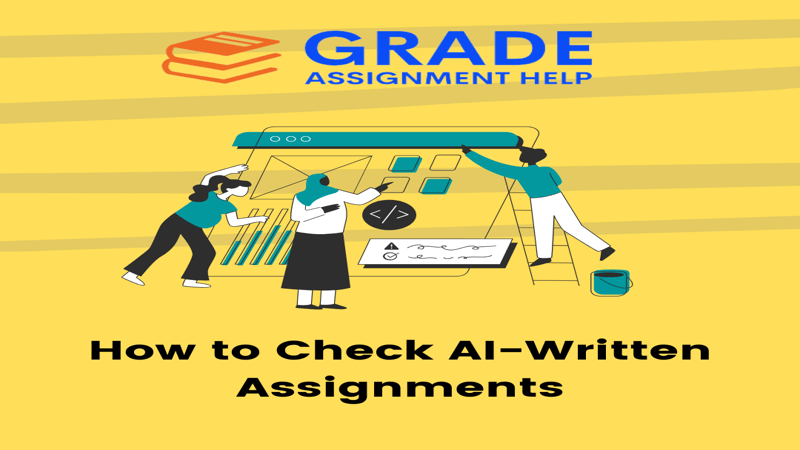

With the advent of artificial intelligence, tools like ChatGPT and other generative AI systems have revolutionized the way we approach written content. While these tools bring immense benefits, they also pose challenges, particularly in academic settings. Educators face the growing challenge of distinguishing between AI-generated and human-written assignments. As AI becomes more sophisticated, this task becomes increasingly complex. This blog aims to provide actionable strategies for identifying AI-written assignments, ensuring academic integrity and fostering authentic learning experiences.
AI tools like ChatGPT use advanced algorithms to generate text based on prompts. These systems analyze vast datasets and employ predictive modeling to create coherent and contextually relevant content. While this technology is powerful, it has certain telltale characteristics:
• Overly Polished Language: AI often produces text that is grammatically flawless but may lack a personal touch.
Generic Responses: AI-generated content can feel broad or lack depth in nuanced topics.
Repetitive Patterns: AI might repeat phrases or ideas in a way that feels unnatural to human readers.
Common scenarios where students may use AI include tight deadlines, lack of subject understanding, or the temptation to produce a polished essay quickly. Understanding these motivations helps educators anticipate potential misuse.
Detecting AI-generated content is not straightforward. Here are some challenges:
Similarity to Human Writing: As AI tools improve, the distinction between human and machine-generated text becomes subtle.
Ethical Dilemmas: Accusing a student of using AI without concrete proof can lead to trust issues.
Tool Limitations: Detection tools may produce false positives or fail to detect more sophisticated AI content.
These challenges underline the need for a balanced approach combining manual review and technological assistance.
Manual Methods
1. Recognizing Patterns: Look for overly formal or consistent sentence structures that may lack variety.
2. Absence of Personal Voice: AI often struggles to mimic the unique perspective or emotional depth present in genuine student work.
3. Superficial Insights: AI-generated assignments might lack deep analysis or fail to address specific nuances of a topic.
Automated Detection Tools
Several tools can aid in detecting AI-written content:
Turnitin: Incorporates AI-detection algorithms to flag potential machine-generated text.
GPTZero: A specialized tool designed to identify text created by models like ChatGPT.
Copyleaks: Offers AI detection alongside traditional plagiarism checks.
These tools analyze text for patterns like perplexity and burstiness, which are markers of AI content.
Cross-Referencing Content
Source Comparison: Check if the content mirrors known AI-generated text or external sources.
Citation Overload: AI tools often over-reference or improperly cite sources, which can raise red flags.
Educators can take proactive steps to minimize reliance on AI tools:
1. Creative Assignments: Design prompts that require personal input, creativity, or local context that AI tools cannot replicate.
2. Oral Assessments: Incorporate interviews or presentations to verify a student’s understanding of the subject matter.
3. Ethics Education: Teach students about the importance of academic integrity and the risks associated with misusing AI.
4. Iterative Assignments: Break assignments into drafts, making it harder to rely entirely on AI tools.
6. Academic Integrity and Its Importance
Academic integrity is the cornerstone of education. It fosters trust, accountability, and the pursuit of genuine knowledge. In the context of AI-written assignments, upholding academic integrity means ensuring that students engage honestly with their coursework. Key principles include:
Originality: Students must produce work that reflects their understanding and effort.
Fairness: Academic evaluations should be based on authentic performance rather than shortcuts enabled by technology.
Responsibility: Both educators and students have roles in promoting ethical practices.
By prioritizing academic integrity, institutions create an environment where learning thrives, and the misuse of AI tools is discouraged.
The use of detection methods raises ethical concerns:
Fairness: Ensure students are not unfairly penalized based on suspicion alone.
Transparency: Clearly communicate the use of AI detection tools to students.
Privacy: Avoid intrusive measures that might compromise student trust.
Balancing these considerations ensures a fair and respectful approach to upholding academic standards.
AI will continue to shape education. Instead of viewing AI as a threat, educators can explore ways to integrate it responsibly. For instance:
AI as a Learning Tool: Encourage students to use AI for brainstorming or drafting ideas, followed by personal refinement.
Updated Policies: Develop guidelines that clarify acceptable AI use in assignments.
Collaboration Opportunities: Use AI to create interactive learning experiences or simulate complex problem-solving scenarios.
By embracing these possibilities, educators can leverage AI’s potential to enhance rather than undermine learning.
In today’s rapidly evolving educational landscape, the challenge of identifying whether an assignment is created by AI or crafted through genuine effort has taken center stage. This shift compels us to reimagine how we uphold academic integrity while navigating the influence of advanced technologies. Through proactive strategies, fostering critical thinking, and encouraging authentic learning, educators and students can work together to maintain a culture of honesty and originality.
Rather than perceiving technology as a threat, it can become an ally in education. For students seeking guidance, personalized support services can empower them to improve their skills while staying true to the principles of academic integrity. With the right approach, technology can enhance learning experiences, help students overcome academic challenges, and promote ethical writing practices.
Let this digital transformation inspire responsible learning and teaching. By ensuring that our pursuit of knowledge remains grounded in honesty and genuine effort, we can create an academic environment that values authenticity, creativity, and personal growth. If you’re looking for academic assistance that respects these values, take help from Grade Assignment Help to get the best assignment help. We ensure assignments are written with integrity and originality, helping you succeed while staying true to your values. A little guidance can lead to great progress!